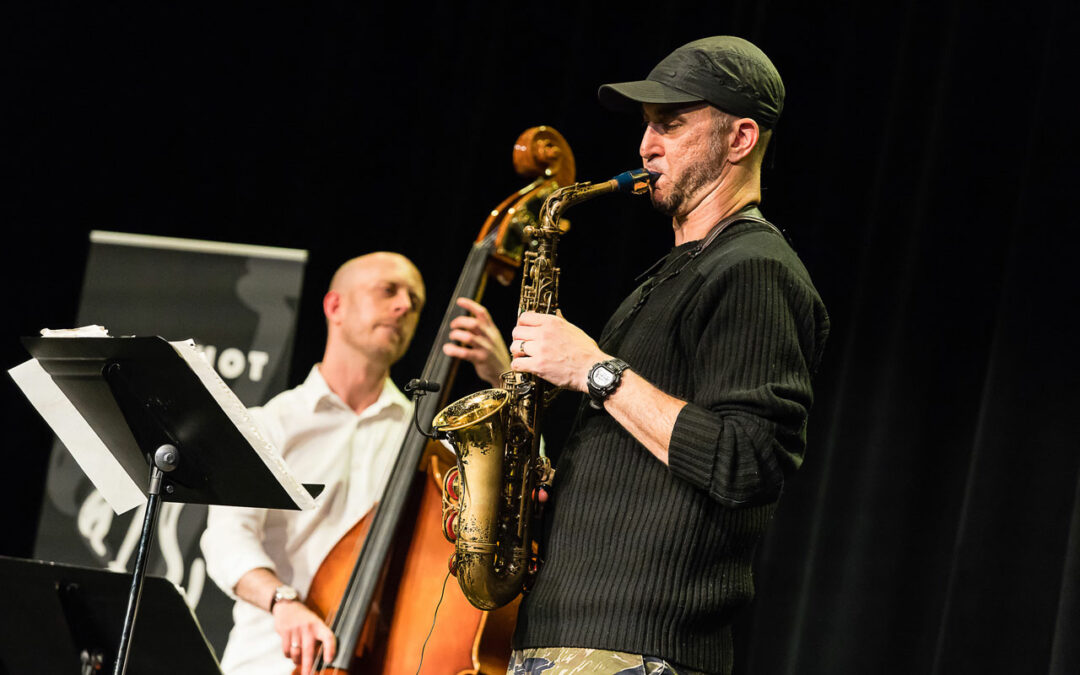Matt Brewer and Steve Lehman photo by Lisa Hagen Glynn
Community Corner is a series that invites the public to contribute their thoughts, reflections, observations, and more about the world around us, particularly as it relates to jazz and music overall. Earshot Jazz is dedicated to amplifying the voices and stories of artists and community members alike. The thoughts and opinions expressed in this series are the author’s own and do not necessarily reflect those of Earshot Jazz. Please email submissions to editor@earshot.org.
As the year comes to an end, we look back on the moments and connections that stuck with us the most. This month, artist and The Goodbye Look host, Peter Graham shares excerpts and reflections from a recent interview with Steve Lehman.
BY PETER GRAHAM
I was able to hear The Steve Lehman Trio through Earshot Jazz in mid-June, and I felt compelled to write down some thoughts after resonating so deeply with the performance. The following is a brief rumination and quick conversation on Steve Lehman’s Trio Performance:
Steve Lehman has been described as a “state of the art musical thinker” by The New York Times, despite not coming through the traditional jazz development pipeline. Eschewing a fully dedicated music school, Lehman received a bachelor’s in composition from Wesleyan University and his doctorate in musical arts focused on composition at Columbia University.
During his performance, there was no strict adherence to the classic jazz tune form, i.e., play the head, have everyone take a solo, play the head out. The compositions flowed seamlessly between pre-written melodic sections and collaborative improvisation.
Lehman’s trio took collaborative improvisation and interaction and executed on it at the highest level. The band flowed between technically and emotionally astonishing improvisational sections, the aforementioned pre-written melodic sections, time signature shifts, and harmonic transformations.
I asked Lehman how he thinks about the forms of songs in his performances:
Very often…I’m thinking about composition as it relates to the environment for the improvisers and group interaction and making that the first priority since that’s usually the thing that takes up the most clock time in a piece. I often think first about what the structural, rhythmic, and harmonic environment for group interaction and improv is going to be. I then sort of work backwards from there…so a lot of times that leads to compositions that don’t adhere to a head – solo – head format because in some ways the head or melodic material isn’t the priority.
After coming out for the encore, Lehman said he would be playing a Coltrane tune (“Moment’s Notice”), joking that “if you all don’t like it, that’s my fault.” Familiarity with a standard like “Moment’s Notice” helps us to see the imprint artists make on a known tune – it allows the voice of the artist to be more readily understood. Listening to Keith Jarrett and Brad Mehldau play “All the Things You Are” back to back can show just how distinct the artist’s respective voice presents in the familiar confines of a known tune.
Hearing Lehman and his trio perform “Moment’s Notice” was a rare instance where there was really no discernible imitation going on, but, instead, was what felt like a complete evolution of the music that kept the soul of Coltrane’s composition completely intact.
In describing his approach to the tune:
It was actually built off an arrangement that I heard Ravi Coltrane perform of a piece by his dad called ‘26-2’, and I sort of reapplied it to ‘Moment’s Notice’ really as a kind of exercise or etude. Then I workshopped it quite a bit in duo with Damion Reid on drums, and eventually an arrangement of sorts emerged.
The arrangement emerging out of improvisational workshopping echoes the “working backwards from interaction” technique described in his compositional philosophy. Even with a timeless standard, the re-interpretation is driven by the improvisational creative process rather than the explicit text of the tune itself.
In performing the tune, Lehman began with his usual effortless dismantling of the changes, with explosive and visceral improvisations. Then he started to imbue his improvisations with pieces of the melody, starting with the timeless coda of the tune, which boomed and resonated with emotion. What felt like the continuum of the jazz tradition emanated through Lehman’s performance.
I asked Lehman if he had any thoughts about his specific evolution of the jazz tradition:
I don’t think too much about being reverent to tradition because I think it’s just sort of embedded into the way that I move through the music. Just because I’ve spent so much time thinking about, listening to, and working on the music – it’s out of my control. Hopefully that reverence and respect for the craft of the music is a more accurate word than “tradition.”
Tune in to Steve Lehman’s latest album, Ex Machina. It’s a brain-expanding hybrid of spectral composition, generative electronic synthesizers, and world-class musicianship that has received rapturous praise from critics.





